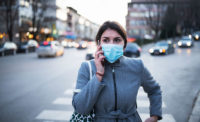Amanda Rawls, South Central District Manager of KPA, answers questions related to janitors, COVID-19 and what employers need to do.
Q: Should janitors use PPE while cleaning commercial buildings? Why? What kind of PPE they should use, at the minimum and ideally?
Amanda Rawls: All employees, including cleaning staff, should wear PPE anytime that PPE is required by their employer’s PPE Hazard Assessment and/or identified as a requirement on the Safety Data Sheet (SDS) of any chemicals that they handle. Cleaning supplies received in bulk and concentrated may have instructions to be diluted prior to use which could require employees to wear gloves and safety glasses while also completing work with adequate ventilation.
Q: Are contractors hiring the janitors responsible to provide the PPE? Why? If not, who?
Rawls: The short answer is contractor vs. onsite facility safety responsibilities can be a grey regulatory area. The OSHA PPE standard only names employers as responsible for identifying hazards and supplying PPE, which may be difficult for companies that are sub-contracted for their work. Generally, from an enforcement perspective, it is the responsibility of the day-to-day supervisor of an employee to assess hazards and any possible need for personal protective equipment. Who is the cleaning crew reporting to and what kind of contract are they completing? Performing general custodial activities will have different anticipated hazards compared to companies that are specifically disinfecting for Covid-19.
The OSHA website has a new section for Covid-19 Control and Prevention to provide interim guidance for specific industries. Environmental (i.e. janitorial services) is one industry that has been highlighted. This guidance highlights examples of environmental service tasks and an associated exposure risk level from Low (caution) to Very High. From the OSHA website, “Generally, environmental service (i.e., janitorial, cleaning) workers do not need special precautions beyond those already used to protect them from the hazards they encounter during their routine job tasks. However, various combinations of engineering and administrative controls, safe work practices, and PPE may be appropriate for environmental services workers, depending on the results of their employers’ hazard and risk assessments.”
Under OSHA’s respiratory protection standard (29 CFR 1910.134), an employer must provide appropriate respirators, such as facemasks, to employees when such equipment is necessary to protect the health of the employees. In light of COVID-19, OSHA has stated that employees in very high-risk and high-risk categories must be provided with adequate PPE, including respirators. Very high-risk employees include healthcare, deathcare, and laboratory workers who perform aerosol-generating procedures on known or suspected COVID-19 patients or who handle specimens or body parts from such patients. High-risk employees are other healthcare and deathcare workers who are exposed to known or suspected COVID-19 patients, but not those exposed to aerosol-generating procedures. For lower risk workers, no additional PPE is recommended.
Since 2008 OSHA does require employers to supply PPE. “Employers should assess the hazards to which their workers may be exposed; evaluate the risk of exposure; and select, implement, and ensure workers use controls to prevent exposure.” Every employer shall ensure that suitable personal protective equipment is provided to employees who may be exposed to a risk to their health or safety while at work except where and to the extent that such risk has been adequately controlled by other means which are equally or more effective.
With few exceptions, OSHA requires employers to pay for personal protective equipment used to comply with OSHA standards. The standard makes clear that employers cannot require workers to provide their own PPE and the worker’s use of PPE they already own must be completely voluntary. Even when a worker provides his or her own PPE, the employer must ensure that the equipment is adequate to protect the worker from hazards at the workplace.
Under OSHA's PPE (Personal Protective Equipment) guidelines, you cannot charge an employee for equipment needed to safely perform a job. However, if an employee chooses to use their own PPE, the employer is not required to reimburse the employee; the burden of making sure this equipment meets the OSHA standard, however, remains on the employer. If an employee has lost or intentionally damaged PPE, the employer is not required to pay for its replacement.
Employers DO NOT have to pay for:
- Non-essential rain gear
- Back belts
- Long pants
- Dust mask/respirators when used voluntarily (29 CFR 1910.134)
- PPE that is lost or intentionally damaged
PPE selection for environmental services workers should reflect:
- Risk and anticipated sources of exposure to SARS-CoV-2
- For routine cleaning, use gloves and gowns, along with any PPE normally used for routine job tasks.
- For cleaning environments contaminated with human blood, body fluids, other potentially infectious materials, or other suspected or known sources of SARS-CoV-2, workers may also need PPE such as masks and eye and face protection.
- Risk and anticipated sources of exposure to potentially hazardous cleaning chemicals
- For routine cleaning, use ordinary commercial-grade cleaning products, and follow manufacturer instructions, including as provided on the Safety Data Sheet, for selecting appropriate PPE to protect workers from chemical hazards.
- For cleaning environments contaminated with human blood, body fluids, other potentially infectious materials, or other suspected or known sources of SARS-CoV-2, use EPA-registered disinfectants with label claims to be effective against the virus, and follow manufacturer instructions, including as provided on the Safety Data Sheet, for selecting appropriate PPE to protect workers from chemical hazards.
Q: Some janitors complain that their employer provided reusable masks that they should wash regularly themselves (as in an added task to their jobs with the washing). Is this employer practice acceptable/correct, or questionable in any way?
Rawls: The practice of reusable masks can be considered questionable, but currently it may be the only practical option to protect employees. Healthcare workers are also reusing masks due to a shortage in PPE. The CDC has provided strategies for optimizing the supply of PPE including guidance on extended use and limited reuse of N95 filtering facepiece respirators and methods for decontaminating and reusing disposable filtering facepiece respirators during crises. The guidelines are intended for healthcare but may help employers in other sectors optimize their PPE supplies.
OSHA will always recommend that employers consider a conservative assessment of PPE for employees. Different respirators have different assigned protection factors so employers need to select respirators that meet or exceed the assigned protection factor for activities requiring respirators. For example, a loose fitting facepiece like a homemade face covering has an assigned protection factor of 0. A self-purifying quarter mask has an assigned protection factor of 5, and half mask/Dust Masks have an assigned protection factor of 10. OSHA recommends choosing PPE with the highest protection factor for employees so supplying an N95 mask would provide more protection then a reusable face covering.
However, due to the pandemic finding an adequate supply of N95 respirators may be difficult. According to OSHA “most environmental services workers are unlikely to need PPE beyond what they use to protect themselves during routine job tasks. However, employers should consider whether their hazard and risk assessments warrant the use of more protective PPE ensembles.” Because finding adequate PPE may be challenging for employers OSHA has published flexibilities for respiratory protection.
Under specific circumstances in which National Institute for Occupational Safety and Health (NIOSH)-certified N95 filtering facepiece respirators (FFRs) are unavailable, and employers follow guidelines to conserve respirators, OSHA's temporary enforcement discretion permits employers to use:
- Other NIOSH-approved respirators, including N99/100, R95/99/100, and P95/99/100 FFRs; elastomeric, air-purifying respirators; and powered, air-purifying respirators.
- NIOSH-approved respirators that are beyond their manufacturer's recommended shelf life (i.e., expired devices).
- Certain respirators certified in accordance with standards of other countries or jurisdictions, including expired devices.
These alternative respirators are expected to provide better protection against SARS-CoV-2 compared to face masks, homemade or improvised equipment, or no respiratory protection at all.
OSHA is also providing enforcement discretion for annual fit-testing requirements of the Respiratory Protection standard (29 CFR 1910.134) to help reduce the rate at which respirators—specifically disposable models—are used and discarded.
See the Enforcement Memoranda section of the Standards page for further information
With any of use of PPE it is critical that it is used correctly and stored appropriately to be effective. Workers should avoid touching their faces, including their eyes, noses, and mouths, particularly until after they have thoroughly washed their hands upon completing work and/or removing PPE.
Q: If questionable, is the employee entitled to a different approach, such as receiving disposable masks for every cleaning session; getting extra pay for COVID-19 hardship, or anything else?
Rawls: At any point an employee can refuse to work if the appropriate PPE is not supplied and an employee safety complaint can be filed with their local area OSHA office. Yes, receiving a new disposable mask for every cleaning session is ideal but considering the PPE challenges during the pandemic it may not be practical. Additionally, OSHA is exercising enforcement discretion when assessing an employers' efforts to act reasonably and in good faith. To my knowledge there is no Covid-19 hardship pay outside of the DOD or any other Federal programs.
https://www.osha.gov/Publications/3352-APF-respirators.pdf
https://www.cdc.gov/niosh/npptl/pdfs/UnderstandDifferenceInfographic-508.pdf



